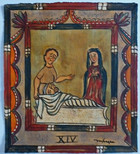Station XIV: Christ is Laid in the Tomb
And he made his grave with the wicked, and with the rich in his death; because he had done no violence, neither was any deceit in his mouth. (Isaiah 53:9)
There is little time to grieve at the foot of the Cross. Practical decisions have to be made. The sun will soon be setting, and the body of Christ must be laid in a tomb before the Sabbath begins or left unburied until the first day of the week. Joseph of Arimathea, who will enter Christian legend as the keeper of the Holy Grail, takes charge of the funeral preparations. A supporter of Christ on the ruling Jewish council, Joseph hurries to see the Roman Governor Pontius Pilate to claim the body.
Crucified criminals were usually left to rot on their crosses to be picked apart by birds and beasts, as a grisly reminder of the power of Imperial Rome. The rules were bent, on occasion, out of respect for Jewish scruples about leaving corpses unburied. We know from Mark 15:43-45 that Joseph “went in boldly unto Pilate, and craved the body of Jesus.” (In other Gospel narratives the verb is translated as “begged.”) The Roman Governor seems surprised to hear Christ has died so soon. Whatever strings Joseph pulls, his request is granted.
Some commentators suggest that Joseph was specially appointed by the Sanhedrin to handle the delicate issue of crucified Jews, who, as criminals, in the Jewish tradition, could not be interred at their family gravesites. There are hints in John 19:41-42 that Jesus was buried in great haste, and a new tomb was used in a garden beside Golgotha “because of the Jew’s preparation day; for the sepulchre was nigh at hand.”
Matthew the Evangelist gives the story a different spin. Apparently, a man of some means, Joseph shows his devotion to Christ by an extraordinary gesture. He buries Jesus in “his own new tomb, which he had hewn out of the rock (Matthew 27:60),” as if Christ were one of the family. This funeral vault, probably, had two chambers, an outer room for preparing the body, and a smaller, inner niche, where the corpse was laid. A stone was rolled into a groove at the outside entrance to seal off the sepulcher.
It was customary in Jesus’ time to wash the body, anoint it with perfume and spices, and wind it in cloth for burial. The Evangelists Matthew, Mark and Luke describe how Joseph, himself, wrapped the body in clean linen. The Evangelist John adds the extra detail that Nicodemus brought along about 75 pounds of costly myrrh and aloes to anoint the corpse.
The faithful women from Galilee follow Joseph to the gravesite and keep watch from outside the tomb. They do not seem to be satisfied with Joseph’s hasty preparations. In a year’s time, the bones will be gathered up and reburied in an ossuary box, and the women want to make sure the corpse has been anointed in the proper way. Time has run out. Evening is at hand. They will just have to come back to Jesus’ gravesite on the first day of the week.
As the Evangelist Luke tells the story, the women returned to their homes “and prepared spices and ointments; and rested the Sabbath day according to the commandment (Luke 23:56).” No one expected to find the tomb empty on Easter Sunday.
When life seems like an endless Saturday of stress, worry, and petty details, help me to remember that Sunday is coming. Amen.
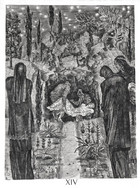
Albert Decaris
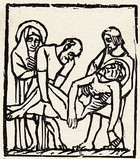
Jean Marchand
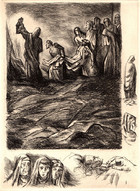
Andre Collot
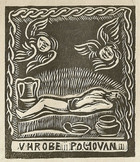
Unknown Czech artist
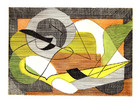
Elisabeth de la Mauviniere
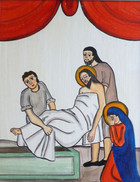
Marie Romero Cash
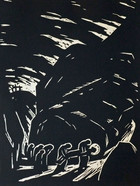
Max Thalmann
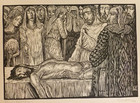
Louis Jou
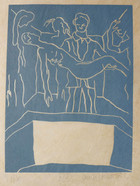
Adrian Wiszniewski
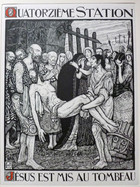
Louis Jou
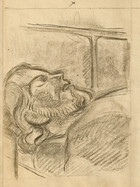
Master of the Stalag VI D Stations
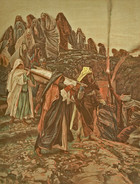
J.J. Tissot
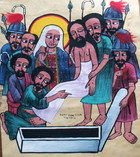
Unknown Ethiopian Artist
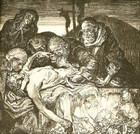
Frank Brangwyn
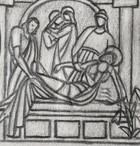
Arthur Kemp

Maurice Denis
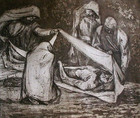
Pat M. Mallinson (Allman-Smith)
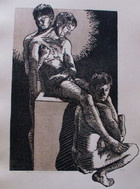
Tyrus Clutter

Milan Entler
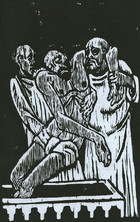
Charles Aldrich
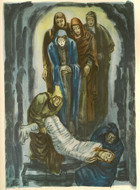
Albert Decaris
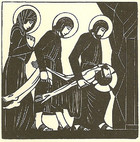
Eric Gill

Luigi Casalino
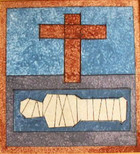
William Schickel
